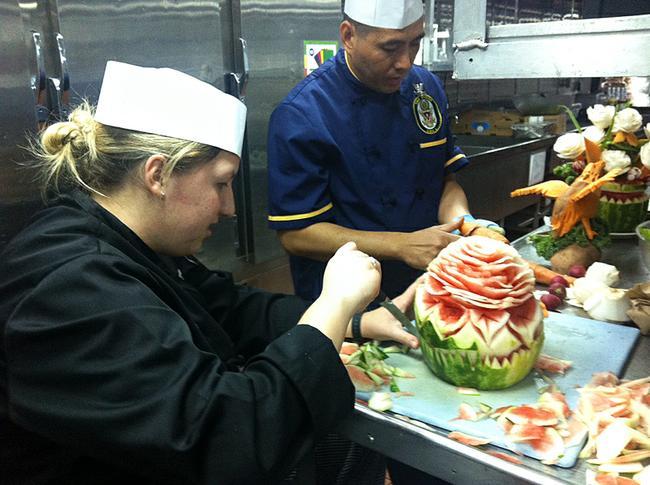
It wasn’t a typical Thanksgiving dinner.
Thirteen 25-pound turkeys, 100 pounds of ham, 180 pounds of prime rib and more than 20 kinds of dessert made up the holiday meal that took place aboard the USS Boxer, an amphibious assault ship of the United States Navy.
“I want to estimate that we served 600 to 700 people,” said junior Emma Faist.
Faist and five other College of Agriculture, Food and Natural Resources students spent Thanksgiving break aboard the ship, docked in San Diego, Calif. Led by Leslie Jett, executive chef and assistant teaching professor, the students collaborated with the Naval Culinary Specialists to help prepare meals for the men and women of the U.S. Navy.
The trip was part of the Adopt-A-Ship program, created by the Naval Supply Systems Command and the American Culinary Federation in 1998 to encourage continued education and foster collaboration among culinarians, according to the [CAFNR website](http://cafnrnews.com/2012/11/thanksgiving-at-sea/). The students spent their holiday break on the 843-foot ship, living and working alongside members of the U.S. Navy.
“We didn’t really know too much going in,” Faist said. “It’s one of those things where you don’t really know what you’re getting into until you’re there.”
The students arrived in San Diego the Sunday before Thanksgiving. Leading up to the holiday, they worked alongside Navy cooks and received firsthand experience working on a U.S. Navy ship.
“We learned a lot, not only about how the Navy works but also about Navy cooking,” said Culley Freese, a junior who participated in the trip. “We got to interact with the crew and help prepare meals. The first couple days they taught us how things work (on the ship), and then by the time we left, we were working hand-in-hand with them to help out with meal preparation.”
The students learned how the Navy operates food services. Cooking on the ship was very different than working in a café or restaurant, Freese said.
“It’s definitely smaller, and there are more tight spaces,” Freese said. “Things were kind of hectic because there are three kitchens cooking for the whole ship.”
Faist said the recipes they used were somewhat based on limited availability of certain food items.
“A lot of the recipes we cooked with involved a lot of canned food items,” Faist said. “If they’re away at sea, they can’t get many fresh items.”
The preparation techniques were stricter on the ship, Faist said.
“(The cooks) are given orders from someone above them, and they’re assigned different parts of the meal, and they just do what they’re told,” Faist said. “There’s not too much freedom when it comes to cooking because they have to follow the recipes pretty exact.”
Differences also carried over into cleanup, Faist said. The cooks were not supposed to clean the dishes because that job was assigned to other workers.
“It was kind of nice for us because we are so used to cooking our food and cleaning up as we go,” Faist said. “They had an entire cleaning staff to do the cleaning. One of our guys kind of got in trouble for cleaning his own space because it was another person’s duty to do that — his orders were to clean. That was really weird to get used to.”
Vast differences aside, the experience was worthwhile, Freese said.
“It was a good bonding experience with my fellow classmates, and it was a good learning experience with all the Navy cooks, just being around them,” Freese said. “I would highly recommend it.”
Jett said his hope was that students now appreciate the work it takes to be a war fighter and to support the war-fighting team.
“They get to see mass production in a way they can’t anywhere else,” Jett said. “But more important, they get to see the military from the inside out. (This is) an insight that I wish every American could have, as it is something they will not soon forget.”